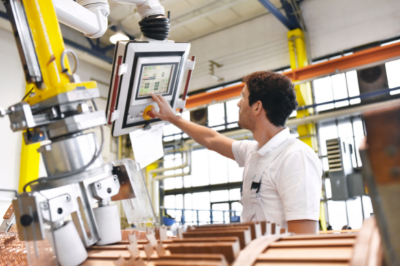

Founder: Turnaround Talk
When Klaus Schwabb, Executive Chairman of the World Economic Forum, introduced the world to the concept of the Fourth Industrial Revolution (4IR), corporates reacted to the presentation with a lot of interest. They had been hearing about the adoption of technology and how the then illusive Big Data would run our lives.
Fast forward to 2020 and the global event that disrupted the established business paradigm. Corporates were now playing catch up plugging holes in their digital strategies to ensure that their companies remained relevant in an increasingly technology based future.
Digitization may be a root cause of financial distressed. When faced with a presentation to investors about why you need funding to increase investment in digital technology, distressed companies should consider the thoughts presented in a recent PwC report which outlines the benefit of digitisation.
Insightful dashboards
The report points out that manufacturers face challenges with dashboards that are either overloaded, not displaying relevant information or are scattered over multiple applications, therefore insights are not translated into actions to optimise business performance. Recent events in the production network and historic reports are not linked to each other, thus holistic decision-making based on a 360° perspective is not possible.
Digital manufacturing platforms provide standardised user-centric dashboards and activity feeds that are used as the single point of information to gain insights, trigger actions and ensure closed loop activities. Development of the integrated dashboards requires input from the manufacturer’s business experts, providing real-time activity feeds employing a user-centric approach to drive better decision-making. Through the dashboards, the user can trigger alerts and actions to ensure closed loop analysis.
The dashboards also enable self-service analytics by supporting mobile devices and natural language queries.

Photo By: Canva
The report adds that through these dashboards, manufacturers are provided with a one, ready-to-use, reporting and reliability portal to monitor and steer production across plants and assets by integrating existing systems and ensuring closed action loops. Increased transparency and comparability across all plants, production lines and assets with reduced efforts to generate personal insights and workflows.
Production analytics
The report points out that in manufacturing, shop floor workers and production supervisors often do not have real-time visibility and lack the analytical insights to identify the cause for plan deviation. Root cause analysis is often performed retrospectively based on historic data days after the production took place and is often limited to machine availability.
To overcome this challenge, digital manufacturing platforms provide real-time dashboards that visualise whether production goals are being met. The application identifies causes of deviation and enables further analysis in a comprehensive report with drill-down functionality. The dashboards allow production supervisors and operators to drill down into the different elements of overall equipment effectiveness (OEE) and into all contributing factors (material, labor, machine, flow).
The report adds that the dashboards also have functionalities to alert the appropriate person or trigger other predefined actions when a production resource is interrupted. The dashboards also provide visualisation of movement patterns and workflows with real-time location information.
With these functionalities, production supervisors can realise benefits from a predefined cockpit with configurable production KPIs which also allows drilling down into details. Each dashboard can be scaled from mobile to desktop view, providing a consistent view in a variety of situations, from a manager’s mobile device to large shop floor screens.
For an effective and end-to-end analysis of production performance, a fully integrated digital approach is required.
Intelligent maintenance
The report points out that, traditionally, maintenance teams were engaged in reactive maintenance which means they focused on responding to daily emergencies such as equipment breakdowns or failures. Maintenance schedules were prescribed and often highly ineffective, which led to workers often firefighting daily challenges and causing safety incidents or delayed production. Due to unused or missing data, no root causes of failure could be identified and consequently no future breakdowns could be prevented.
Current asset management solutions often don’t focus on the business implications of the status of an asset. This makes it difficult for shop floor staff to determine whether a change in an asset’s status jeopardizes daily production targets. Often, when technical teams such as maintenance, engineering, or quality need to be involved, they are informed manually with a time gap that hinders quick resolution.
The report adds that the introduction of digital manufacturing platforms enables the provision of realtime asset information and sends alerts to appropriate persons in case of deviation conditions from the desired plan, in order to trigger intelligent countermeasures like re-scheduling and paperless maintenance procedures.
This is done through pre-configured solutions that help manage critical assets more effectively by using pre-trained algorithms and insights for asset performance. This includes artificial intelligence (AI) based pattern recognition of error states which trigger associated countermeasures for maintenance scheduling or paperless maintenance, as well as assurance of maintenance procedures to increase quality and safety.
The introduction of this platform functionality enables benefits including preconfigured asset management data models and ‘dashboards that matter’ visualisations that can be customised to meet specific requirements. Preconfigured connections to machine level data as well as integration into maintenance schedules (e.g. SAP PM) and paperless maintenance systems.

Photo By: Canva
Predictive quality
The report points out that most industries are unable to resolve their quality problems due to too many interfaces, heterogeneous data sources and lack of analytical capabilities, which prevents them from enabling their workforce to perform end-to-end root cause and subsequent defect analysis. Furthermore, not all relevant quality features are available to create a clear defect image as input for the decision-making process, e.g. all features for the end-ofline testing process. Through digital manufacturing platforms, manufacturers can be provided with dashboards that visualise all the necessary information on quality issues in the factory floor. Through the platform, a variety of data types can be combined providing insights, enabling manufacturers to react fast or even predict quality issues before they occur.
The report adds that digital manufacturing platforms enable root-causes and subsequent defect analysis for quality issues by providing ‘best-in-class’ methods that combine all relevant data sources. The platforms are also pre-built with analytical models like clustering and classification algorithms to detect quality issue patterns and rework recommendations, e.g. in the end-of-line testing.
Digital manufacturing platforms can provide capabilities to reduce rework efforts and optimise machine configurations to increase product quality and reduce required resources for quality assurance, e.g. test benches. They can also increase both the speed of quality analysis as well as the quality level through the use of artificial intelligence.
The adoption of data driven predictive quality measures enables capabilities to improve quality operations and help to realise the following benefits:
- Reduce product quality issues (scrap, loss and waste, warranty and returns).
- Performance improvement (optimum asset utilisation and performance, minimum
- process instability and variability).
- Enables the shift from a focus on correction to a focus on prevention.
Digital lean
The report points out that although adoption of conventional lean provides benefits to manufacturers, over the last few years, it has shown decreasing incremental benefits. Adoption of digital lean can reveal untapped benefits by leveraging data-based waste identification, to reveal hidden improvement potentials. One of the functions of digital manufacturing platforms is to enable the digital lean capability for manufacturers, by providing the digital toolsets to enhance traditional lean methods and tools to generate additional transparency on the shop floor for further efficiency gains.
Digital manufacturing platforms can do this by digitising traditional lean tools, e.g. analogue shop floor management and capturing the data in a structured way (including ‘non-smart’ machines and workplaces). Digital manufacturing platforms can also enable the digital visualisation of shop floor incidents, analyse them and use them during shop floor meetings to systematically eliminate waste. Through the platform function, assignment and tracking of countermeasures for shop floor incidents is enabled.
The report adds that digital lean implementation on the platform can reveal untapped benefits by leveraging data-based waste identification to uncover hidden improvement potentials.
Digital twin
The report points out that most companies are not able to track and trace the journey of one specific product throughout the production process. This prevents them from identifying root causes of customer complaints, due to bad quality and to narrow down the defects to specific parts, instead of batches.
With a digital manufacturing platform, companies can track and trace a specific part throughout the production process and trace the exact production conditions and resources used for each part. With the digital twin component of the platform, manufacturing processes of a production line — e.g. type of machines, type of processing, type of workers etc — can be described in detail so that any changes to the process can be evaluated / simulated digitally.
The report adds that, with this functionality manufacturers can benefit from a standard reporting and reliability portal to monitor and steer production across plants and assets, by integrating existing systems and ensuring closed-loop action. Furthermore, manufacturers benefit from increased transparency and comparability across all plants, production lines and assets with reduced effort to generate personal insights and workflows.
The role of the turnaround professional
When faced with financial distress, companies will be tempted to return to basics and focus on the core strengths that made them profitable in the past.
However, as pointed out in the introduction, the old paradigm has been disrupted and multi-generational companies simply cannot return to their old ways because the world we live in today is so vastly different from the world we lived in two years ago, let alone five years ago.
Turnaround professionals need to encourage companies to be forward looking and focus on how current actions need to be different from past actions. I have mentioned the Pandemic as an accelerant of the 4IR; however, the 4IR would have disrupted the paradigm even without Covid. The only difference is that change would have been a lot slower.
What could have been a five year transition into digital technology became a two year transition. This pace of change will only increase and it is important for companies to show their investors that they are geared towards digital technology. It is the direction that the world is moving towards.




